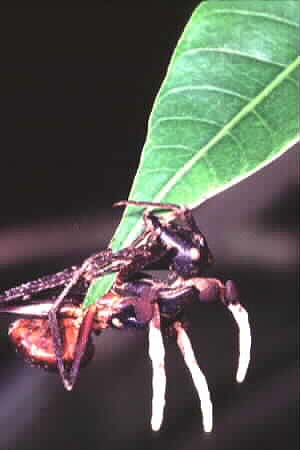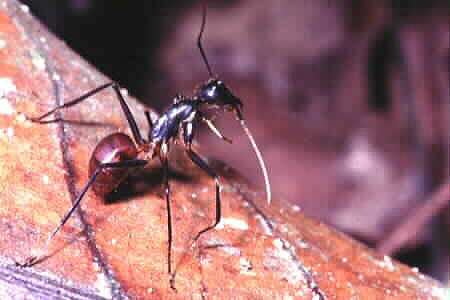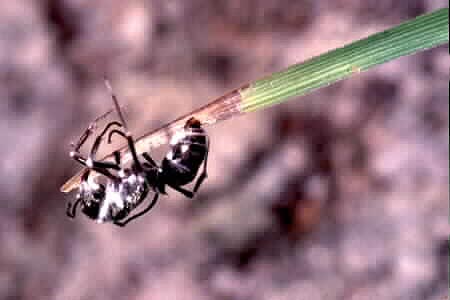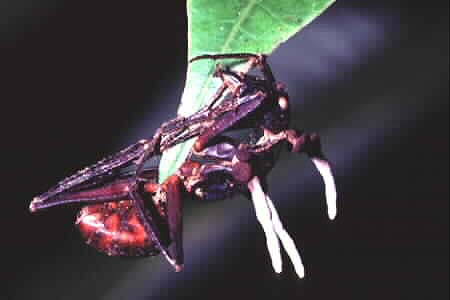 THE Giant Forest Ant (Camponotus gigas) is one of the largest ant species in the world.
It measure about 2.5cm or one inch in length. With its size and huge mandibles, it must
appear formidable to the smaller denizens of the forest understorey. However, like the many
other insect species which inhabit the Malaysian forest, it also has its predators in the food
chain, and is susceptible to parasitic attacks.
THE Giant Forest Ant (Camponotus gigas) is one of the largest ant species in the world.
It measure about 2.5cm or one inch in length. With its size and huge mandibles, it must
appear formidable to the smaller denizens of the forest understorey. However, like the many
other insect species which inhabit the Malaysian forest, it also has its predators in the food
chain, and is susceptible to parasitic attacks.
This writer encountered a specimen of C. gigas which had been completely ravaged by
a fungal parasite in the Ulu Ampang Recreation Forest (just outside Kuala Lumpur) in early
1995. Agitated as the parasite grew insidiously inside its body, it had climbed onto a mango
sapling, about two feet tall.
Perhaps wracked by persistent pain, it had then clenched its jaws, biting into the drip
tip of a leaf. Here its shrivelled body hung, and death was certain for this giant ant when
the fruiting bodies of the fungus grew through its exoskeleton at the joints.
At a talk for members of the Malaysian Nature Society at FRIM (Forest Research Institute,
Malaysia), Kepong, in March 1995, mycologist Dr Roy Watling, of the Royal Botanic Gardens,
Edinburgh, said this parasitic fungus is a species of Cordyceps closely related to
Cordyceps sinensis or the “tung chung chou” of Chinese traditional medicine.
 The modus operandi of this parasite, as related by Dr Watling, goes like this: The minute,
airborne spores of the fungus find their way into the tracheae of an insect, such as the
Giant Forest Ant, as it breathes through its spiracles or pores. The mycelia of the fungus then
starts to grow, absorbing the host’s body tissues as they spread. The mycelia avoid the
vital organs so that the host does not die immediately but continue to provide nourishment to
the growing fungus. Amazing, isn’t it?
The modus operandi of this parasite, as related by Dr Watling, goes like this: The minute,
airborne spores of the fungus find their way into the tracheae of an insect, such as the
Giant Forest Ant, as it breathes through its spiracles or pores. The mycelia of the fungus then
starts to grow, absorbing the host’s body tissues as they spread. The mycelia avoid the
vital organs so that the host does not die immediately but continue to provide nourishment to
the growing fungus. Amazing, isn’t it?
With this alien organism taking over its body, the ant is somehow compelled to climb to the
highest point of a tree that it is able to reach in its weakened state. It clings onto a leaf,
usually one that is near the top. Here, with mandibles clamped onto the tip of the leaf, it
eventually dies. Several days after the spores find their mark, the fruiting bodies of the fungus
develop through the ant’s exoskeleton.
The mature fruiting bodies then burst and release clusters of tiny capsules into the air.
These capsules in turn explode as they float downwards, spraying spores over the surrounding
area and infecting any unwary and unlucky insect passing through when this happens. The life
cycle of the fungus is thus completed.
 Some time after the first picture (top) was taken, this writer returned to the spot hoping
to record any further development. Unfortunately, the mango sapling had been cut and the area
cleared by the forest rangers taking care of the recreation park. However, at another spot nearby,
the writer found a different species of ant, smaller than C. gigas, that had also been
killed by a different kind of parasitic fungus.
Some time after the first picture (top) was taken, this writer returned to the spot hoping
to record any further development. Unfortunately, the mango sapling had been cut and the area
cleared by the forest rangers taking care of the recreation park. However, at another spot nearby,
the writer found a different species of ant, smaller than C. gigas, that had also been
killed by a different kind of parasitic fungus.
Cordyceps sinensis parasitises caterpillars, producing the “tung chung chou”
imported from China and sold in local medicine shops as a tonic for speeding up recovery from
illnesses. While C. sinensis is beneficial to humans in this respect, the various species
of Cordyceps are certainly bad news for the many insect species which they parasitise in
the larval, pupal and adult stages.
This articles was published in Nature Malaysiana, Vol 21 No 3
(September, 1996).
|











